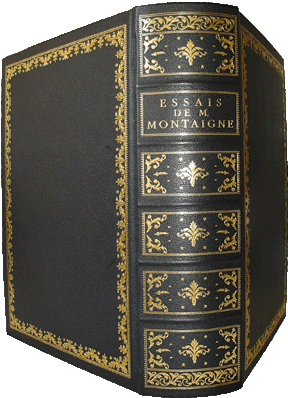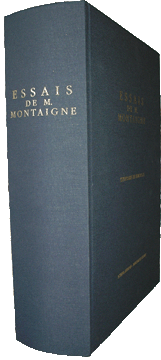|
The Story Behind the Bordeaux Copy Reproduction The color reproduction of the Bordeaux Copy of Montaigne's
Essais was published in July 2002. After more than four years of hard work rhythmed by administrative and scientific hurdles, this editorial project comes finally to an end! Such scientific endeavor was made possible with the support of the French Ministry of Culture, the City of Bordeaux, the Montaigne Club of Dallas, the University of Chicago and Montaigne Studies, and has required a heavy financial investment and unprecedented technical innovations. In order to complete this edition, the Bordeaux Copy of Montaigne's Essais was photographed in the vault where it resides. Strict technical specifications were imposed by the City of Bordeaux and the Bibliothèque Nationale de France technical services. The numerous photographic sessions occurred at the Bordeaux library, the electronic conversion of the ektachromes was done at the University of Chicago and the printing on high quality paper (close to the original) was done in Italy by Grafischena. Finally, the leather (morocco) binding-identical to the Bordeaux Copy for the first 120 numbered copies-was done in France. The result is a fantastic monument (more that 13 pounds!) to the memory of Montaigne and a unique research and teaching tool for scholars working on the Renaissance. Montaigne's handwriting has never been so legible (richer and more readable than the black and white reproduction published by Hachette in 1912 and far superior to the "reproduction of the reproduction" published by Slatkine). The color reproduction allows students and scholars to multiply endlessly the famous layers of Montaigne's text as the visible differences in the ink colors open new possibilities of interpretation for key passages of the Bordeaux Copy. *** I invite you to order this color reproduction or at least have your library order it. It is an indispensable research and teaching document. All the specialists of Montaigne and the French Renaissance will finally be able to have access to this important book. Philippe Desan
|
Click on the pages below to see a high-quality image from the Bordeaux Copy reproduction. (NB: images are very large)
Copy bound in leather and numbered A-Z or 1-80 ($1580 or $1180)
Copy bound in cloth ($620)
|
What is the Bordeaux Copy?
What is today commonly called the Bordeaux Copy is a printed copy of
the last edition published during the lifetime of Montaigne by Abel
L'Angelier in 1588. This copy is copiously annotated in Montaigne's
hand. These numerous additions, suppressions and corrections, visible in the margins as well as in the body of the text, represent
typographical variants, word substitutions, punctuation alterations, and
even stylistic changes. But it is especially the textual developments
(which Montaigne called "allongeails")-written between the Summer of
1588 and September 13 1592 (date of his death) which literally invade
the blank space of the margins. These additions show us how Montaigne
worked on his Essais. It is for this reason that the
Bordeaux Copy represents a unique and rare document. Indeed, according
to Montaigne, the Essais represent a "bundle of so many disparate
pieces", a book which has built itself up with diverse interruptions and
intervals". The Bordeaux Copy possess about one third of manuscript
additions when compared to the printed text of
1588. This document is precious for its peculiar status: part manuscript
and part printed book. It enables us to better understand what Montaigne
meant when he confessed wanting to "try himself" and write "as long as
there is ink and paper in the world".. The Bordeaux Copy can be seen as
a palimpsest of memory and judgment.
***
Ce qu'on appelle aujourd'hui communément l'Exemplaire de Bordeaux
(EB) est en fait un exemplaire imprimé de la dernière édition des Essais
publiée du vivant de Montaigne chez Abel L'Angelier en 1588. Cet
exemplaire est abondamment annoté de la main de l'auteur. Ces nombreux
ajouts, suppressions et corrections, présents aussi bien dans les marges
que dans le corps du texte, concernent à la fois des modifications
typographiques, des substitutions de mots, des interventions sur la
ponctuation et la graphie, et même des variations de style. Mais ce sont
surtout les développements (que
Montaigne nomme « allongeails ») - rédigés entre l'été 1588 et le 13
septembre 1592 (date de sa mort) - qui envahissent littéralement
l'espace libre des feuillets et nous éclairent ainsi sur la façon dont
Montaigne travaillait à ses Essais. C'est à ce titre qu'EB
représente un document unique et inestimable. A en croire Montaigne,
les Essais ne seraient qu'un «fagotage de tant de diverses pieces», un
livre qui « s'est basty à diverses poses et intervalles ». EB possède
environ un tiers d'apports manuscrits par rapport au texte imprimé de
1588. Cet ouvrage est précieux par la particularité (du moins pour un
document du XVIe siècle) de son statut - en partie imprimé et en partie
manuscrit. Il nous permet de mieux comprendre ce que Montaigne entend
quand il déclare vouloir « s'essayer » et écrire « autant qu'il y aura
d'ancre et de papier au monde ». Car EB est
bien un palimpseste de la mémoire et du jugement.
|





